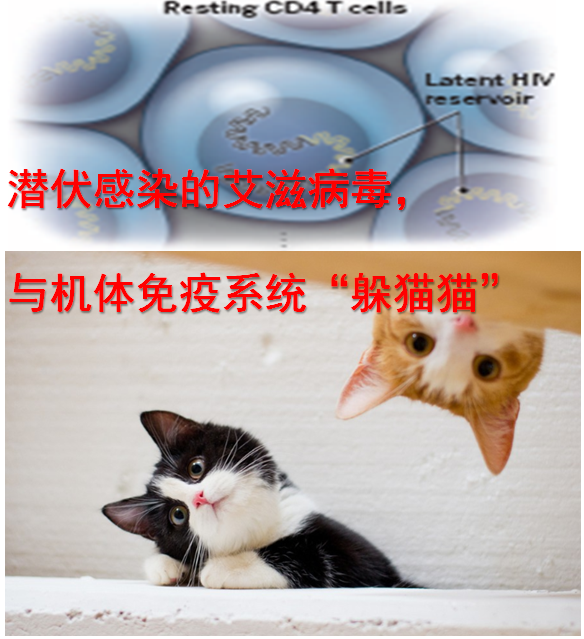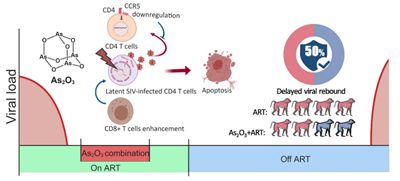Scientists have found that arsenic trioxide helps improve the treatment of existing anti-HIV drugs May 21, 2019 Source: Sun Caijun Science Network Blog AIDS (HIV/AIDS) is a highly toxic viral infection that poses a serious threat to global public health. About 36.9 million people worldwide are currently infected with HIV, and an additional 1.8 million infected people are added each year. The AIDS epidemic in China is also very serious. According to the China Center for Disease Control and Prevention, by the end of 2018, China estimated that there are about 1.25 million people living with HIV, and the trend of rapid growth has not been curbed. For example, only 135,000 were discovered in 2017. Newly infected people. What is even more worrying is that the AIDS epidemic in China has changed from high-risk local populations such as drug abuse and blood sales to sexual spread of the general population. More than 95% of new infections are infected through same-sex or heterosexual behavior. Existing antiviral therapy (ART) controls the progression of AIDS, but it does not eradicate the virus in patients. Once the drug is stopped, the virus will rebound quickly. AIDS patients must take medicine for life, which leads to a series of problems such as drug resistance, side effects and economic burden. Therefore, it is urgent to develop a new strategy that can control or even completely cure HIV infection for a long time. There are many reasons why AIDS can hardly be cured. The most important point is that after HIV infection of host cells, it can be integrated into the host cell genome within 1-3 days, so that it can be established in the body to establish a stable and stable virus base camp (virus repository). . These HIV camps, like branding, are co-dead with host cells, posing great difficulties for routine drug treatment and vaccine prevention. Moreover, these virus base camps are usually in a silent state - the virus does not replicate, nor does it produce virus-specific proteins, so from the outside, these cells stationed in the virus base camp are very similar to the normal cells of the body, and are veritable hidden killers. However, when the body is stimulated or the immunity is low, these base camps will be active, sending out a batch of virus terrorists to carry out terrorist activities, and harming the innocent host cells around them. Once they encounter antiviral drugs or immune killer cells, they will be hidden again, making it difficult for drugs or immune killer cells to disappear. In the face of these virus terrorists who "take a shot and change a place", the regular army (immune system) in the body responsible for clearing infected cells is also helpless, and there is no way to do it. This is the key reason why most anti-HIV drugs cannot eradicate viral infections. Therefore, how to effectively eliminate the terrorist base camp is an important scientific issue to cure HIV infection. The researchers envisioned "stimulating" the latent viral camp to make it active, making it easier for these terrorist nests to be detected and discovered, and then killing them through drugs or the immune system, that is, "first lead the snake out of the hole, then trap and kill." Destroying the old nest will be an effective strategy to cure AIDS infection. In order to solve this problem, researchers from the Chinese Academy of Sciences, Zhongshan University and other units first through a series of in vitro experiments, found that arsenic trioxide (As2O3) can specifically activate the latent virus reservoir without causing excessive inflammatory response, and then in the monkey AIDS The in vivo therapeutic effect of As2O3 in combination with ART was verified in a viral (SIV) chronically infected macaque model. The therapy caused a significant delay in the rebound of the virus after SIV-infected monkeys, and even some of the experimental monkeys did not show a viral rebound after 80 days of discontinuation (the average rebound time of the ART-treated group alone was 22 days). In addition, the therapy was found to be effective in reducing the number of viral reservoirs in SIV-infected monkeys and significantly enhancing the virus-specific immune response. More interestingly, the researchers also found that As2O3 treatment can down-regulate the expression levels of CD4 receptors on the surface of CD4+ T cells and CCR5 co-receptors (which cannot be invaded without HIV), thereby effectively blocking infectious viruses. A new round of infection and spread of particles. It is worth noting that As2O3 is the main component of arsenic. The arsenic is commonly known as the stone, crane red, etc. It is a well-known highly toxic drug. However, it is a three-point drug, which is a seven-drug drug. The wise Chinese nation realized the medicinal value of arsenic more than 2,000 years ago and used it for diseases such as anti-malaria infection. For example, in the ancient books of medicine such as "Shen Nong's Herbal Classic", "Preparation for Emergency", and "Compendium of Materia Medica", it is recorded that the arsenic can be used to "treat malaria" and "severing malaria". In the modern medical era, the As2O3 preparation for injection has been approved by the Chinese and US Food and Drug Administration for the treatment of cancers such as acute promyelocytic leukemia, and has good clinical efficacy and safety. The scientific research from the Chinese Academy of Sciences, Zhongshan University and other units shows that As2O3 preparations can also be used for the treatment of AIDS. It is reported that the research team will conduct clinical trial research in accordance with the relevant requirements of the National Drug Clinical Trial Quality Management Regulations to further verify the therapeutic effect of the therapy on AIDS patients. The work was titled "Arsenic trioxide impacts viral latency and delays viral rebound after termination of ART in chronically SIV infected macaques" and published in Advanced Science (DOI: 10.1002/advs.201900319). Professor Chen Ling from the Guangzhou Institute of Biological Sciences , Chinese Academy of Sciences, Zhongshan Professor Sun Caijun from the School of Public Health (Shenzhen) and Professor Thomas Lehner from King's College London are co-authors of the paper. Food additive is indispensable in food, food manufacturers need to add the food additives in the production process, in order to change the food color, smell, or adjust the taste of food, and for a time, such as Preservatives and antioxidants, and Sweeteners, such as these are most of food additives, plant extracts, through professional technology of extraction, There are many kinds of food additives, mainly: preservatives, colorants, sweeteners, spices, leavening agents, acidity regulators, antioxidants, thickeners, emulsifiers and Food Additives,Tbhq Active Ingredients Powder,Custom Citric Acid,Useful Plant Extractpowers so on. Food Additives,Tbhq Active Ingredients Powder,Custom Citric Acid,Useful Plant Extractpowers Xi'an Henrikang Biotech Co.,Ltd , https://www.xianhenrikangbio.com



Scientists have found that arsenic trioxide helps improve the treatment of existing anti-HIV drugs
Original link address: http://blog.sciencenet.cn/blog-2443200-1180121.html